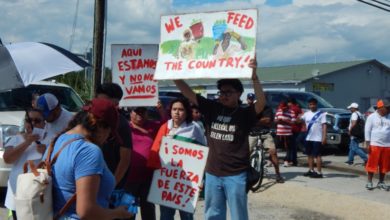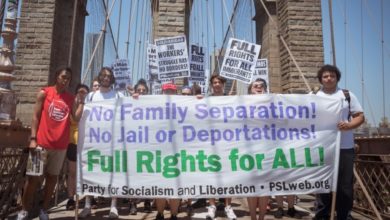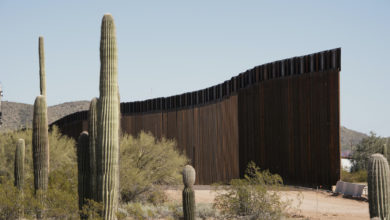 Thousands of peasants march against CAFTA in front of the Nicaraguan National Assembly, May 26, 2005. Photo: Mario Lopez |
The agreement represents the latest attempt by transnational corporations to increase the exploitation of the peoples of the underdeveloped world, in particular the people of Central America. Central American workers used May Day as an occasion to hold massive demonstrations against the trade pact.
President Bush has made CAFTA a top priority of his administration, because it will help accelerate the implementation of the Free Trade Area of the Americas.
The implementation of CAFTA is one element of the larger goal of corporate globalization. Neoliberal policies put corporations and market forces in control of the people. They trample on national self-determination, removing any semblance of sovereignty by heads of state and governments. It is a new form of colonialism, a model based on economic annexation.
The impact of CAFTA
CAFTA represents a serious attack on labor rights in particular, and human rights in general.
The treaty would open the door to privatization of public services, lower wages, more sweat shops, more maquiladoras, greater destruction of the environment and a greater disparity between rich and poor.
One of the most dangerous consequences of CAFTA would be the destruction of the peasant economy. The agricultural policies of the free trade agreements threaten the sustainability of rural communities. CAFTA will force peasants to sell their raw material at extremely low prices to compete with U.S. agribusinesses flooding local markets with foreign goods produced by advanced techniques at low prices.
These policies are particularly treacherous for Central America, because they prevent local governments from carrying out reforms to benefit the rural population, historically the most vulnerable sector of society. It’s hardly an exaggeration to argue that CAFTA represents the total extermination of the Central American peasantry.
Under CAFTA, essential public services such as health care, drinking water, education, food and housing, will be threatened with drastic cuts or outright elimination. Although policies regarding health, education, labor, energy and the environment should be exempt from the rules of commerce, under CAFTA they are considered “trade barriers,” and subject to the demands of multinational corporations. As a result, basic public services in Central America will be less accessible, more expensive, and of lower quality. The new order will have an especially severe impact on women and children, since they depend most on government-provided services.
U.S. big business views CAFTA as a first step towards a greater treaty, the Free Trade Area of the Americas (FTAA), which will include every country of Central America, South America, and the Caribbean, with the exception of Cuba.
Opposition growing
While most of the Central American governments have signed on to the pact, they do not represent their countries’ workers and peasants. That has been shown in the many demonstrations and mobilizations across the region.
In the United States, the labor movement has also opposed the pact. Union leaders argue that jobs will disappear as corporations take advantage of the drastically lower wages in Central America. As evidence, they point to the consequences of the North American Free Trade Agreement involving the United States, Canada and Mexico.
Small businesses both in the United States and in Central America have also opposed the pact. These small businesses already have difficulty competing with the big corporations and agribusinesses.
Unions point out that the trade agreements do not protect labor rights, which will lead to the deterioration of working conditions and wages in both Central America and the United States. The few rights that Central American workers enjoy, such as the 40-hour workweek, social security, and the right to unionize are already disappearing. These rights were won through decades of long and arduous struggle. CAFTA aims to destroy those rights completely.
CAFTA: migration and exclusion
Closely connected to the increased corporate attempts to exploit Central America are an increased number of immigrants coming from this region to the rich countries of the world in search of better living conditions. This is directly related to the implementation of neoliberal policies: structural adjustment plans, privatization and the restriction of workers’ rights.
To describe the extent of the immigration phenomenon, it’s sufficient to mention just a few facts. According to the International Labor Organization, more than 120 million immigrants left their countries in the 1990s.
Central America stands out for the growing numbers of immigrants. Between 300 and 500 people look to leave the region daily in irregular or underground circumstances. From Peru 250,000 to 300,000 people emigrate annually, headed to Argentina, Chile, Japan, Italy, Spain and the United States. Ecuador’s situation is no different; more than 290,000 left that country between 2000 and 2001, headed to Europe and the United States. In Spain, there are 300,000 Ecuadorians, half of whom are undocumented or underground. Nearly four million Mexicans and four million Central Americans are in the same situation in the United States. Of the two million Brazilians living abroad, half are in the United States.
In their home countries, these migrants face a growing disparity between the rich, the few who live in great opulence, and the great unemployed majority. Desperately in search of improved living conditions and no longer able to satisfy their basic needs as the cost of living reaches ever higher, many from the working classes as well as the more well-to-do middle classes see immigration as the solution.
While the world’s wealth is concentrated in fewer and fewer hands, the number of people in poverty grows at an accelerating rate. The world’s gross domestic product is estimated at $25 trillion. Around $18 trillion of that is produced in the seven richest countries. The other $7 trillion comes from the rest of the world—more than 180 countries. Of the 500 biggest companies that together account for three percent of the world’s GDP, 85 percent are based in the United States, a country with hardly four percent of the world’s population but 22 percent of the world’s wealth.
To continue its domination of the world, the United States always aims to expand its trade, or more specifically, to sell its products abroad without restrictions or trade tariffs. CAFTA, like the many other free trade agreements and the proposed Free Trade Area of the Americas arose out of this necessity.
These treaties are designed to make U.S. exports easier, not to solve the social problems of Central America—as some of its proponents claim. On the contrary, the implementation of the treaties will worsen these social problems, while destroying national production and thereby increasing unemployment and migration. They will destroy the local economies, lead to cultural deterioration and widen the disparity between the majority who are dispossessed and the minority in power.
Emerging anti-imperialist struggles
Now more and more people are struggling for the necessary rights of our people. The demands for sovereignty, identity, autonomy and freedom are merging with the demands for jobs and social services. More and more the lines are being drawn between the vast majority of people—in Latin America and in the United States—and finance capital with its insatiable greed, debt enslavement, political manipulation and economic corruption. The struggle against the trade agreements is evolving into a struggle against imperialism.
The migrants today traveling to the rich countries carry with them a great transformative and mobilizing potential—due to their culture, customs and different forms of putting forward and demanding their rights. The exodus of migrants to the rich countries highlights the urgent necessity of economic and political changes in the poor countries. The finance capital concentrated in the developed world is the same capital that in the underdeveloped nations would attend to the basic needs of the population, create new opportunities and therefore diminish the need to migrate.
Conscious of this reality, the working class movement in the United States has the challenge of motivating and energizing immigrants to participate in popular struggles. If finance capital does not want borders, why should walls exist for immigrants? The walls against immigration could be physical or they could be in the form of new restrictive legislative reform, as exists in this country, France, Italy and Spain, to name just a few.
Globalizing solidarity and the workers’ struggle is becoming more and more necessary every day. The immigrants’ struggle contributes to this cause.






